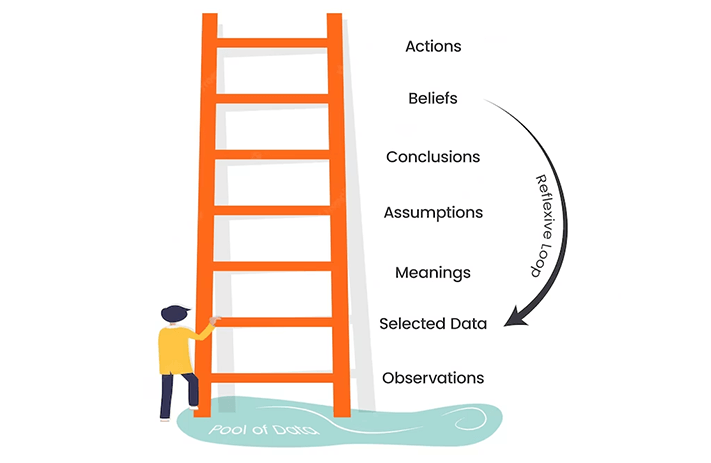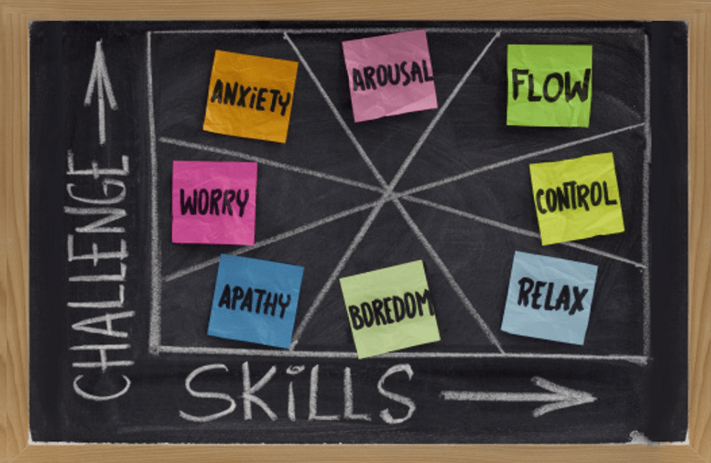
Click the button to start reading
How the Ladder of Inference Shapes Our Decisions and Beliefs
Are you often left scratching your head, wondering how your colleague arrived at such a different conclusion from the same set of information?
Don’t worry; you’re not alone.
This is where understanding the concept of the Ladder of Inference comes in handy. This fascinating psychological model decodes how individuals often subconsciously process information and form conclusions.
By understanding and using this model, you’ll be able to demystify communication quirks, enhance collaboration, and foster a more understanding and productive work environment.
In this article, we will look at the ladder of inference model and go through some examples to help you and your team to understand this concept.

What Is the Ladder of Inference?
The Ladder of Inference is a concept that helps us understand how we think. It shows the steps our minds go through when we see something, think about it, and then do something based on our thoughts.
The inception of the Ladder of Inference traces back to organizational psychologist Chris Argyris and his exploration of organizational learning. The model has since been popularized by Peter Senge in his book “The Fifth Discipline,” which describes it as a powerful way to enhance individual and team learning.
Understanding the Ladder of Inference begins with recognizing its seven rungs. Each rung represents a step in our mental process when faced with a situation or information. These steps are:
- Observing data and experiences: This is where we start, with raw, unfiltered information.
- Selecting data from what we observe: We can’t process everything, so we filter and select specific data based on our past experiences and biases.
- Adding meaning to the selected data: We then interpret the selected data, giving it context and meaning.
- Making assumptions based on the meaning we’ve added: Based on our interpretation, we start making assumptions.
- Drawing conclusions from our assumptions: Our assumptions then lead us to conclusions.
- Adopting beliefs based on our conclusions: Over time, these conclusions become our established beliefs.
- Taking actions based on our beliefs: These beliefs drive our actions.
Understanding the Ladder of Inference helps us see how we think and make decisions. It can help us notice when we might make assumptions or jump to conclusions. In a work environment, it can also help us understand other people’s points of view and work better together.

Climbing the Ladder: Steps and Examples
The Ladder of Inference’s seven-step process demonstrates how we move from observing a situation to taking action based on our beliefs. Each step is critical in forming our conclusions and beliefs.
Let’s break down each rung with corresponding examples:
Observing Data and Experiences
This is the starting point of the Ladder of Inference, where we are fully immersed in reality and observe the world in its most raw and unprocessed form. This can include anything from physical events we witness, conversations we overhear, or changes in our environment. We take in this raw data through our senses without yet forming interpretations or conclusions.
Example: In a team meeting, you witness a usually talkative colleague who is remarkably quiet.
Selecting Data from What We Observe
As our brains are constantly bombarded with massive amounts of data, we can’t possibly pay attention to everything. Therefore, our mind begins to select certain aspects from the pool of raw data that seem most relevant or significant to us. Our personal experiences, biases, and current context largely influence this selection process.
Example: Given your past experiences and your value for open communication, you focus on the silence of your usually talkative colleague.
Adding Meaning to the Selected Data
Once we’ve selected data, we start to attach meanings to it. We interpret the selected data based on our personal and cultural backgrounds, life experiences, values, and beliefs. This step involves inferring the implications of the selected data, giving it a certain meaning or significance in our minds.
Example: Based on your interpretation, you ascribe meaning to your colleague’s silence, considering it as a sign of disengagement or disagreement.
Making Assumptions Based on the Added Meaning
After attaching meaning to the selected data, we start to form assumptions. These assumptions are inferences or deductions that go beyond the existing information, filling gaps in our understanding and offering a plausible explanation that aligns with the meaning we have attributed to the data.
Example: Based on the meaning you’ve ascribed to your colleague’s silence, you assume they are unhappy or displeased with the project’s direction.
Drawing Conclusions from Our Assumptions
The next step involves drawing conclusions based on our assumptions. These conclusions are often regarded as personal truths or facts about the situation. They offer a comprehensive narrative that connects the selected data, inferred meaning, and our assumptions.
Example: Based on your assumption, you draw the conclusion that your usually vocal colleague is unsupportive of the current project or the team’s performance.
Adopting Beliefs Based on Our Conclusions
As we climb further up the ladder, our conclusions shape or reinforce our beliefs. Beliefs are generalizations about the world, other people, or ourselves that we hold to be true. They are more ingrained and long-lasting than conclusions, significantly influencing our perspective and behavior.
Example: This conclusion strengthens a belief that your colleague, who you thought was highly invested in the team’s success, may not care about this project’s outcome.
Taking Action Based on Our Beliefs
The final rung of the ladder is where our beliefs guide our actions. Since we consider our beliefs to be valid and true, our actions are seen as appropriate responses to the situation at hand. These actions are in line with our understanding of reality, as shaped by the previous steps on the ladder.
Example: Guided by this belief, you may decide to confront your colleague about their silence or bring up your observations and concerns with your team lead or manager.
By understanding each step, we can work towards making more informed, balanced decisions, particularly in a collaborative environment like the workplace.

The Role of the Ladder of Inference in Communication
The Ladder of Inference is pivotal in how we perceive and communicate with the world around us. Shaping our understanding of experiences largely influences how we listen, respond, and interact.
When we communicate with others, we do so through the lens of our beliefs, conclusions, and assumptions. This lens, crafted by climbing the Ladder of Inference, can act as both a facilitator and barrier in communication.
The Ladder of Inference provides a mental shortcut, enabling us to swiftly interpret and respond to the vast amount of data we encounter daily. It helps us make sense of our experiences and react accordingly.
However, the Ladder of Inference can also foster misunderstanding and miscommunication. Since our perception and interpretation of data are largely subjective, our understanding of a situation can differ greatly from that of others. These differences can lead to communication gaps and conflicts.
For example, two people observing the same event may select different data, ascribe varying meanings, and form contrasting beliefs.
When they communicate their views, they may find it challenging to understand each other’s perspectives, leading to possible conflicts or misunderstandings.
The process of climbing the Ladder of Inference is often subconscious; we may not even realize that our understanding and communication are being influenced by it.
We may firmly believe that our perspective is objective, overlooking the personal biases and assumptions that have shaped it. This lack of awareness can further exacerbate communication challenges.

Using the Ladder of Inference for Better Decision Making
A powerful aspect of the Ladder of Inference is its ability to expose our biases and assumptions and, in doing so, offer a tool for reducing them. By understanding how our minds build beliefs from experiences, we can take steps to mitigate the influence of unchecked bias and assumptions in our decision-making and communication.
Spotting Bias with the Ladder
The Ladder of Inference illustrates that our conclusions and beliefs are not directly born from raw data or experiences. Instead, they are crafted from our interpretation of the selected data, an interpretation that can be heavily swayed by personal biases.
Understanding this process enables us to spot where our thinking might be skewed and where bias may be creeping in.
For instance, if you find yourself frequently in conflict with a particular coworker, you might be selecting data that reinforces your negative view of them and ignoring data that contradicts it. By recognizing this bias, you can strive to be more balanced in your selection of data, which could lead to a more objective view of the person.
Making Better Decisions
When we move up the Ladder of Inference, we make decisions about what data to focus on, what meaning to ascribe to it, and what actions to take based on our beliefs. We can make more conscious and thoughtful decisions by becoming aware of this process.
For example, if you’re leading a team project, you might subconsciously select data that supports your preferred approach, leading you to dismiss other potentially valuable strategies. By consciously descending the Ladder of Inference—checking your assumptions, considering all available data, and revisiting your interpretations—you can ensure that your decision is well-informed and balanced.
In essence, the Ladder of Inference serves as a mental ‘checklist’ that can help us navigate our thinking more effectively. Using it as a tool for introspection, we can challenge our biases, assumptions, and thought patterns, promoting clearer thinking and better decision-making.
Conclusion
The Ladder of Inference isn’t inherently negative—it’s simply a representation of how our brains make sense of the world. The key lies in awareness and intentional action.
This self-awareness, combined with a deliberate examination of our thought processes, can empower us to navigate our world more effectively.
Pause for a moment and ask yourself: “Where am I on the ladder right now? Am I making assumptions? Could there be other valid interpretations of the data?” This simple act of introspection could be a game-changer, leading to clearer understanding, more effective communication, and more informed decisions.
















